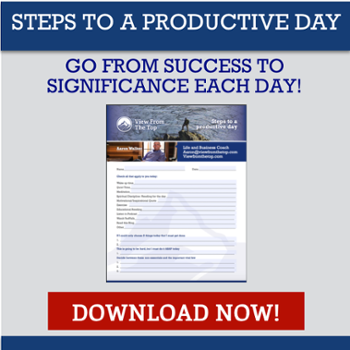
Every time our online mastermind groups go through Mike Michalowicz’s book, Profit First, I find stuff I can riff on by reading just one chapter. Take a quick look at this excerpt, because it’s foundational for what I’m about to tell you:
Jason Fried, cofounder of Basecamp, wrote an article for Inc., in which he talked about the demise of his favorite Chicago pizza joint. The owners did everything right - except that they grew too fast. After building their business slowly, they suddenly scaled from twenty to forty locations. Sales could not outpace their debt, and Fried’s beloved pizza chain was forced to close.
Can you imagine being the owners of that franchise, and the difference in the tune they sang when they opened location #21 versus when they closed the last remaining store? What kind of things would you start believing - about yourself, the world, and God - if that happened to you?
That’s why I’m grateful for your attention today, as we talk about The Right Growth for You. Now you think, “Big A! How do you know what’s right for me? I don’t claim to know what’s right for you.” You’re absolutely right, I don’t know exactly what’s right for you.
What I can tell you is there’s a faulty belief in the business world that “more” automatically equals “better.” Unfortunately, many men have taken painful spills down a steep mountainside pursuing that goal. I’ve been a coach and mentor to a few of them. “More” is vague, which should tell you straight away you’re grasping at straws. But that rarely stops people from charging ahead.
Pursuing Real Profit
Mike has a wise word about profit:
Profit is not an event … it’s not something that happens at year-end or the end of your five-year plan or someday. Profit isn’t even something that waits until tomorrow. Profit must happen now and always. Profit must be baked into your business. Every day, every transaction, every moment. Profit is not an event. Profit is a habit.
That’s some strong medicine. How does it sound to you? Are you currently increasing revenue, but not profiting? Have you pulled out so much hair that your head’s starting to look like mine when I haven’t shaved it? I know some of you will read this and feel like profit just gained another lap running away from you.
My heart breaks for men fighting this uphill battle, when there’s so much power at their fingertips. How is it we understand we need to reverse-engineer personal growth, customer experience and so forth … but we’re content to leave money to its own devices? It’s like when Jesus asked the religious leaders, “You can interpret the appearance of the heavens … how can you not interpret the signs of the times?”
Turning your business into a profit-generating machine is like any other business concept - it becomes simple once you reverse-engineer it.  That’s a critical component in our mastermind groups - the accountability culture spurs many men to start thinking ahead more often. That isn’t something society teaches us to do.
That’s a critical component in our mastermind groups - the accountability culture spurs many men to start thinking ahead more often. That isn’t something society teaches us to do.
In fact, Mike tells us to reverse-engineer for profitable growth. If I can be so bold, I’d like for you to compare how you currently manage your money against the following questions:
- Who gets paid first when your business generates revenue? Suppliers? Creditors? Payroll? (There are no right/wrong answers here, just write it down.)
- What percentage of your income gets eaten by things other than profit? For every $1000 you take in, how many dollars are “earmarked” as soon as they arrive?
- How do you allocate operating expenses, taxes, owner compensation and so forth? Do you use an envelope system to portion them out?
- How do you protect percentages of your income as assets that begin to grow independently? What passive mechanisms do you have to offset a downturn, or help pay the freight while you adapt your business to new realities?
If you can’t see these as factors in your income equation, it becomes difficult to determine if your business makes a profit or not. I’d advise you to invest in a business coach or master mind group to help you get more clarity on the numbers.
When Profit’s Not First
Now, let’s suppose you write down answers to these questions. Let’s say, for the sake of discussion, your business earns $500,000 a year in revenue. The first thing you’d want to determine is how much of that is “spoken for” before it hits your account.
You start with payroll, taxes, suppliers and overhead. To over-simplify, let’s say that eats up $350,000. So right from the get-go, you know you’re “paying $350,000 for the privilege of earning $150,000.”
Now at this point, you’ve got $150k as your simple, CPA definition of “profit.” We’re not even talking about incidental expenses here, or the setbacks many businesses encounter due to marketplace fluctuations and customer fickleness. If it was this simple, you could just do an owner’s draw of $150k and call it good, right?
Wrong. The problem is, you’ve still got incidental expenses. You can count on something happening to upset the balance. A vehicle breaks down, a lease gets renegotiated or canceled, product returns defective, employees quit or you have to fire someone. All these events have price tags, so you do need higher and more frequent profit margins. The question becomes, “Where do you get those higher margins?”
As we’ve already discussed in last week’s blog, it’s not enough to simply “make more and more sales.” That’s sending us back downstream without a paddle … we’re back to thinking “more” automatically equals “better.”
Profit First
In our masterminds online, we counsel entrepreneurs to trim that leftover amount even further and include profit. Mike tells people to start with just one percent of gross. That’s not normally a good margin, but if you aim too high you won’t have enough to live on.
So let’s say, of that remaining $150k, you’re willing to part with half in your profit account and the other half of it as household income. That represents a 15 percent margin - well above average, and something you can build on.
If Murphy’s Law kicks in, you’ll have a runway to buy time. When you put profit first, it’s like purchasing “time credits” that allow you to continue normal operations under abnormal circumstances.
Let’s say one of your vehicles needs an entire replacement for its engine and transmission. They don’t come cheap, but you don’t blink … you know you can afford to have it fixed or purchase a replacement, which might be less expensive. It never touches your personal income.
But if nothing happens between now and next quarter, you can still withdraw some of it as distributions. You can invest in the business. You can build a financial portfolio with it. You can diversify revenue and invest in other passive sources, like real estate.
I hope you see how this works. We’re studying this heavily in our masterminds online, and we’d love for you to join us.





